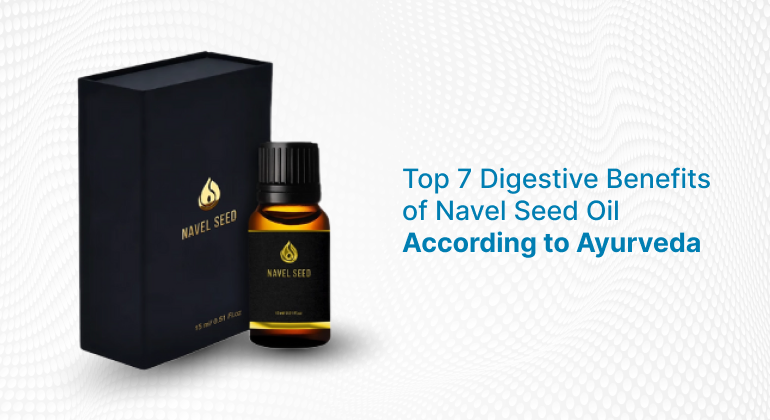Digestive issues have become increasingly common due to poor dietary habits, stress, and sedentary lifestyles. Bloating, gas, acidity, and irregular bowel movements can interfere with daily comfort and overall health. While modern treatments often rely on temporary solutions, Ayurveda offers a gentle yet powerful alternative that works by restoring balance to the body’s internal systems. One such time-honored remedy is the use of Navel Seed Oil for Digestion.
In Ayurvedic healing, the navel — known as the nabhi — is more than just a physical center of the body. It is considered an energetic hub connected to numerous veins and nerves linked to the digestive organs. Applying warm herbal oil to the belly button stimulates these channels, improving circulation, calming internal inflammation, and enhancing digestive function. This method, part of what is traditionally called abdominal relief through Ayurvedic oil therapy, has been practiced for generations in Indian households to maintain digestive wellness.
Navel oiling not only supports the functioning of the stomach and intestines but also strengthens the gut-liver connection and promotes better nutrient absorption. By using natural oils such as castor, mustard, or infused herbal blends, this therapy helps to clear digestive blockages, reduce discomfort, and encourage regularity — all without invasive treatments or chemical medication.
Blending ancient wisdom with simplicity, this therapeutic practice offers a holistic way to bring relief to a strained digestive system and support long-term gut health.
Key Benefits of Navel Seed Oil in Ayurveda for Digestive Health
Navel Seed Oil in Ayurveda is valued for its ability to balance doshas, stimulate digestive fire (Agni), and relieve common gut issues like bloating, acidity, and constipation. It supports natural detoxification and promotes overall digestive harmony.
The Role of the Navel in Ayurvedic Healing
In Ayurveda, the navel (nabhi) is considered the central hub of the body’s life force (prana) and is believed to be the origin point of 72,000 energy pathways or nadis. From a physiological and energetic standpoint, this region is deeply connected to digestion, circulation, and the balance of the three doshas — Vata, Pitta, and Kapha.
When the navel is stimulated through oiling, it’s thought to activate nearby organs such as the stomach, liver, and intestines. This helps improve the movement of digestive juices and the absorption of nutrients. Ayurveda teaches that applying warm oil to the navel soothes Vata imbalances, which are often responsible for issues like gas, bloating, and constipation. Since Vata governs movement in the body, harmonizing its function in the digestive tract is crucial for maintaining regular bowel habits and optimal digestion.
By caring for the navel area, practitioners aim to calm the nervous system, support digestive fire (Agni), and restore gut harmony — all key pillars of Ayurvedic medicine.
Traditional Uses of Belly Button Oil for Internal Balance
The practice of belly button oiling, or nabhi chikitsa, has been part of Indian household traditions for centuries. Elders often used warm mustard or castor oil in the navel area to treat stomach pain, indigestion, or even colic in infants. Beyond physical healing, this ritual is considered a way to nurture internal equilibrium — connecting body, mind, and digestive strength.
Oil applied to the navel is absorbed by the capillaries in the abdominal region and spreads to the internal organs. This method is used not only for digestion but also to address hormonal imbalance, menstrual discomfort, dry skin, and fatigue. The simplicity of this therapy makes it accessible and consistent with the Ayurvedic principle of self-healing through daily rituals (dinacharya).
When applied consistently, navel oiling helps regulate the internal temperature, softens hardened tissue, reduces inflammation, and gently supports detoxification. It acts as a stabilizer that brings harmony to the internal systems — especially the digestive and nervous systems.
Why Navel Therapy is Key to Digestive Wellness in Ayurveda
Digestive wellness is central to Ayurveda. The system believes that most diseases begin in the gut, and keeping Agni (digestive fire) strong is essential for vitality. Navel therapy provides a targeted, non-invasive way to strengthen digestion by working through the very point that connects various internal systems.
When you apply herbal or seed oil to the navel area, it seeps into the layers below and begins to influence intestinal movement, bile flow, and enzyme activity. This leads to better metabolism, reduced accumulation of toxins (ama), and more efficient nutrient breakdown.
By calming excess Vata and balancing Pitta — the dosha responsible for heat and transformation — navel oiling creates a harmonious digestive environment. It reduces cramps, relieves flatulence, eases acidity, and prevents the kind of erratic digestion that leads to chronic discomfort. This is why many Ayurvedic practitioners recommend navel therapy as a foundational treatment in digestive care plans, especially for those seeking gentle, daily support for gut health.
How Navel Oil Supports Healthy Digestion in Ayurvedic Practice
Ayurveda views digestion as the foundation of overall health. When digestion is weak, it can lead to toxin buildup (ama), fatigue, and chronic discomfort. One effective yet gentle way to support digestive wellness is through navel oiling — the practice of applying warm herbal oil to the belly button. This technique helps activate internal systems that govern digestion, absorption, and elimination. By focusing on this central energy point, Navel Seed Oil for Digestion offers a holistic way to restore gut balance and reduce common digestive issues.
Activating the Digestive Fire (Agni)
In Ayurveda, Agni is the core digestive energy responsible for breaking down food and absorbing nutrients. When Agni is weak, it leads to symptoms like bloating, heaviness, and sluggish metabolism. Applying navel oil helps stimulate this internal fire by warming the abdominal region and calming erratic Vata energy. The gentle massage and warmth from the oil improve circulation and nerve response, reigniting digestive efficiency. A consistent navel oiling routine can help strengthen Agni, which is essential for long-term gut health.
Supporting Liver and Bowel Function
The navel area is centrally located and connected via nerves and subtle energy channels to key digestive organs, including the liver and intestines. When seed oil is applied to this point, it penetrates the skin and stimulates the surrounding tissues, encouraging better liver function and bowel regulation. The liver plays a critical role in breaking down toxins and producing bile — both crucial for digestion. Meanwhile, healthy bowel function ensures that waste is efficiently eliminated. Navel oiling supports both by reducing inflammation, relaxing tension in the abdominal wall, and aiding smoother elimination.
Relieving Indigestion, Gas, and Cramps Naturally
Many digestive discomforts — such as gas, acidity, and stomach cramps — are related to imbalanced Vata and Pitta doshas. Navel oiling offers a calming and grounding effect that helps soothe these disruptions naturally. Oils like castor, mustard, or herbal blends reduce bloating by relaxing the abdominal muscles and easing intestinal spasms. The process also helps expel trapped gas and improve peristalsis — the natural movement of the gut. Regular use brings relief from indigestion without relying on synthetic medication, aligning with Ayurveda’s principle of natural healing through daily self-care rituals.
How to Use Navel Seed Oil for Better Digestion

Applying navel seed oil is a simple yet powerful daily ritual in Ayurveda. When used consistently, it helps calm the nervous system, stimulate digestive organs, and improve overall gut health. Knowing the right time, choosing the appropriate oil for your body type (dosha), and following the correct method are key to getting the most benefit from this practice.
When and How Often to Apply the Oil
For best results, navel oil should be applied daily, preferably at night before bedtime. The body is in a resting state overnight, which allows the oil to penetrate deeply and activate healing at the gut level. It’s ideal to apply the oil on an empty stomach or a few hours after your last meal. Consistency is crucial — making it a part of your night routine will deliver long-term digestive benefits.
Best Oils for Each Dosha (Vata, Pitta, Kapha)
In Ayurveda, choosing the right oil according to your dominant dosha enhances the therapy’s effectiveness:
- Vata: Use warm sesame oil or castor oil. These oils are heavy, warming, and grounding — perfect for calming gas, bloating, and dryness.
- Pitta: Opt for coconut oil or ghee. These are cooling oils that help soothe acidity, inflammation, and burning sensations.
- Kapha: Use mustard oil or dry ginger-infused oil. These are heating and stimulating oils that help reduce sluggish digestion and improve circulation.
Step-by-Step Application Method
- Lie on your back in a comfortable position with your stomach exposed.
- Warm the oil slightly (lukewarm, not hot) to enhance absorption.
- Apply 3–5 drops directly into the navel.
- Massage gently in circular motions around the navel for 2–3 minutes.
- Leave the oil overnight and rinse off in the morning if needed.
This practice is non-invasive and easy to do at home. It becomes even more effective when combined with mindful eating and Ayurvedic digestive herbs.
Can Navel Oil Improve Digestion and Gut Health Naturally?

Navel oiling is gaining renewed attention as a natural remedy for digestive health, but many still wonder if it truly works. Rooted in Ayurvedic tradition and supported by both historical use and modern experiences, this method offers more than just surface-level benefits. From stimulating internal organs to calming the nervous system, applying oil to the navel addresses the root of digestive imbalances in a gentle, holistic way.
Insights from Ayurvedic Practice and Case Studies
In Ayurveda, the navel is considered the origin point of life and the center of vital energy pathways (nadis). Practitioners have long recommended navel therapy (nabhi chikitsa) for improving digestion, especially in those with weak Agni (digestive fire), irregular bowel movements, or bloating caused by Vata imbalance.
Several Ayurvedic case studies and clinical observations have shown positive outcomes. For instance, mustard oil and castor oil have been used in Panchakarma (Ayurvedic detox) therapies to relieve constipation and cleanse the colon. Applying such oils at the navel helps stimulate nerve endings connected to the intestines and stomach, encouraging better peristalsis and digestive enzyme activity.
Common Results Observed by Regular Users
People who practice navel oiling regularly often report improvements such as:
- Reduced bloating and gas
- Better digestion after meals
- Relief from acid reflux or heartburn
- More regular and complete bowel movements
- A calmer stomach during stress or travel
Users also mention that this practice helps them feel more centered, relaxed, and connected to their body. These real-world results may not be “clinical trials,” but they carry weight due to consistency and simplicity.
Is It Safe and Effective for Everyone?
Navel oiling is generally safe for most people, especially when using pure, organic oils suitable for their body type. However, individuals with skin allergies, open wounds, or certain pregnancy conditions should consult a healthcare provider before starting.
It’s also important to choose the right oil:
- Castor oil may be too strong for daily use in some cases.
- Mustard oil can be warming and may irritate sensitive skin.
- Coconut or sesame oil is usually gentle and safe for all doshas.
When done properly, navel oiling is a non-invasive, cost-effective, and side-effect-free method for improving digestive health and enhancing gut function.
Final Thoughts on Navel Seed Oil for Digestion
Navel seed oiling is more than just an age-old tradition — it’s a gentle, effective way to support digestive health naturally. By applying the right Ayurvedic oil to the belly button, you stimulate vital energy points that influence the stomach, liver, and intestines. This practice helps reduce bloating, improve digestion, and restore balance to the gut without any side effects.
For best results, make this a part of your evening wellness ritual. Apply 3–5 drops of oil before bed, massage gently, and allow your body to absorb its healing properties overnight. Over time, you may notice less digestive discomfort, more regular bowel movements, and an overall sense of abdominal relief.
At Painflame, we combine traditional Ayurvedic practices with expert guidance to help you achieve long-term digestive wellness. Whether you need help choosing the right oil or creating a full gut-healing routine, our team in Gurugram is here to support you every step of the way
Recent Blog : Navel Oiling with Navel Seeds oil : The Best Natural Remedy for Naabhi Wellness
Frequently Asked Questions (FAQs)
What is abdominal relief through Ayurvedic oil therapy?
It’s a natural way to feel better when you have stomach discomfort. In Ayurveda, this therapy involves putting warm oil—like navel seed oil—on your belly button. It helps relax your stomach, improve digestion, and reduce gas or pain in the abdomen.
Can navel seed oil help with bloating and indigestion?
Yes, navel seed oil is a popular natural remedy for bloating and indigestion. When you apply a few drops of oil to your navel, it helps your stomach settle, reduces gas, and supports smooth digestion. It’s a simple way to feel lighter and more comfortable.
Which Ayurvedic oils are good for digestion?
Ayurveda recommends oils like mustard, castor, sesame, and navel seed oil to boost digestion. These oils help strengthen your digestive fire (Agni), making it easier for your body to break down food and absorb nutrients better.
How does applying oil to the belly button help the gut?
This is part of belly button healing techniques. The navel is connected to many nerves in your stomach area. Putting oil there can help calm your digestive system, reduce pain, and support better gut health. Navel seed oil is especially good for this.
What are some traditional Indian oil methods for better digestion?
Traditional Indian oil practices for digestion include putting oil on the belly button, oil massages, and warm herbal oils. Navel seed oil is often used in these practices to reduce cramps, bloating, and support overall stomach health.
Are there any home remedies for stomach pain or discomfort?
Yes, many! You can drink warm water, eat light food, and apply navel seed oil to your belly button. This is one of the best home remedies to soothe stomach discomfort naturally. It’s safe, easy, and doesn’t need any medicine.







